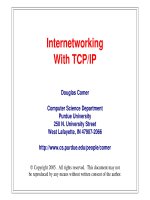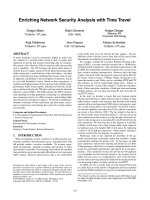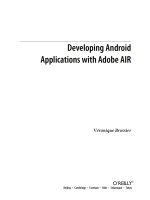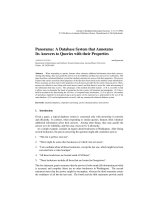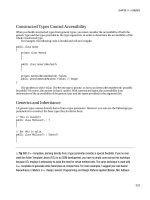Internetworking with TCP/IP- P19 pot
Bạn đang xem bản rút gọn của tài liệu. Xem và tải ngay bản đầy đủ của tài liệu tại đây (512.62 KB, 10 trang )
148 Classless And Subnet Address Extensions (CIDR) Chap.
10
The chief advantage of dividing
an
IP address into two parts arises from the size of the
routing tables required in routers. Instead of keeping one routing entry per destination
host, a router can keep one routing entry per network, and examine only the network
portion of a destination address when making routing decisions.
Recall that the original
IP
addressing scheme accommodated diverse network sizes
by dividing host addresses into three primary classes. Networks assigned class
A
ad-
dresses partition the 32 bits into an 8-bit network portion and a 24-bit host portion.
Class
B
addresses partition the 32 bits into 16-bit network and host portions, while class
C
partitions the address into a 24-bit network portion and an 8-bit host portion.
To understand some of the address extensions in this chapter, it will be important
to realize that individual sites have the freedom to modify addresses and routes as long
as the modifications remain invisible to other sites. That is, a site can choose to assign
and use IP addresses in unusual ways internally as long as:
AU
hosts and routers at the site agree to honor the site's addressing scheme.
Other sites on the Internet can treat addresses as a network prefix and a host
suffix.
10.3
Minimizing
Network Numbers
The original classful IP addressing scheme seems to handle all possibilities, but it
has a minor weakness. How did the weakness arise? What did the designers fail to en-
vision? The answer is simple: growth. Because they worked in a world of expensive
mainframe computers, the designers envisioned an internet with hundreds of networks
and thousands of hosts. They did not foresee tens of thousands of small networks of
personal computers that would suddenly appear in the decade after
TCP/IP was
designed.
Growth has been most apparent in the connected Internet, where the size has been
doubling every nine to fifteen months. The large population of networks with trivial
size stresses the entire Internet design because it means (I) immense administrative
overhead is required merely to manage network addresses,
(2)
the routing tables in
routers are extremely large, and
(3)
the address space will eventually be exhausted?.
The second problem is important because it means that when routers exchange informa-
tion from their routing tables, the load on the Internet is high, as is the computational
effort required in participating routers. The third problem is crucial because the original
address scheme could not accommodate the number of networks currently in the global
Internet. In particular, insufficient class B prefixes exist to cover all the medium-size
networks in the Internet. So the question is, "How can one minimize the number of as-
signed network addresses, especially class B, without abandoning the 32-bit addressing
scheme?"
To minimize the number of addresses used, we must avoid assigning network pre-
fixes whenever possible, and the same
IP
network prefix must be shared by multiple
physical networks. To minimize the use of class
B
addresses, class C addresses must
be
used instead. Of course, the routing procedures must be modified, and all machines
that connect to the affected networks must understand the conventions used.
+Although there were many predictions that the
lPv4
address space would
be
exhausted before the year
Sec.
10.3
Minimizing
Network
Numbers
149
The idea of sharing one network address among multiple physical networks is not
new and has taken several forms. We will examine three: transparent routers, proxy
ARP,
and standard
IP
subnets.
In
addition, we will explore anonymous point-to-point
networks, a special case in which no network prefix needs to
be
assigned. Finally, we
will consider classless addressing, which abandons the rigid class system and allows the
address space to
be
divided in arbitrary ways.
10.4
Transparent
Routers
The
transparent router
scheme is based on the observation that a network assigned
a class
A
IP
address can
be
extended through a simple trick illustrated in Figure 10.1.
Figure
10.1
Transparent router
T
extending a wide area network to multiple
hosts at a site.
Each host appears to have
an
IP
address
on
the
WAN.
The trick consists of arranging for a physical network, usually a WAN, to multi-
plex several host connections through a single host port. As Figure 10.1 shows, a spe-
cial purpose router,
T,
connects the single host port from the wide area net to a local
area network.
T
is called a
transparent router
because other hosts and routers on the
WAN do not know it exists.
The local area network does not have its own
IP
prefix; hosts attached to it are as-
signed addresses
as
if they connected directly to the WAN. The transparent router
demultiplexes datagrams that arrive from the WAN by sending them to the appropriate
host (e.g., by using a table of addresses). The transparent router also accepts datagrams
from hosts on the local area network and routes them across the WAN toward their des-
tination.
To make demultiplexing efficient, transparent routers often divide the
IP
address
into multiple parts and encode information in unused parts. For example, the
AR-
PANET
was assigned class
A
network address
10.0.0.0.
Each packet switch node
(PSN)
on the
ARPANET
had a unique integer address. Internally, the ARPANET treat-
ed any Coctet
IP
address of the form
I0
.p.
u.
i
as
four separate octets that specify a
150 Classless And Subnet Address Extensions (CIDR) Chap.
10
network (lo), a specific port on the destination PSN
@),
and a destination PSN (i).
Octet u remained uninterpreted. Thus, the ARPANET addresses 10.2.5.37 and
10.2.9.37 both refer to host 2 on PSN 37.
A
transparent router comected to PSN 37
on port 2 can use octet
u
to decide which real host should receive a datagram. The
WAN
itself need not be aware of the multiple hosts that lie beyond the PSN.
Transparent routers have advantages and disadvantages when compared to conven-
tional routers. The chief advantage is that they require fewer network addresses because
the local area network does not need a separate
IF'
prefm. Another is that they can sup-
port load balancing. That is,
if
two transparent routers connect to the same local area
network, traffic to hosts on that network can be split between them. By comparison,
conventional routers can only advertise one route to a given network.
One disadvantage of transparent routers is that they only work with networks that
have a large address space from which to choose host addresses. Thus, they work best
with class
A
networks, and they do not work well with class
C
networks. Another
disadvantage is that because they are not conventional routers, transparent routers do not
provide
all
the same services as standard routers. In particular, transparent routers may
not participate fully in ICMP or network management protocols like SNMP. Therefore,
they do not return ICMP echo requests (i.e., one cannot easily "ping" a transparent
router to determine if it is operating).
10.5
Proxy
ARP
The terms proxy
ARP,
promiscuous
ARP,
and
the
ARP
hack
refer to a second tech-
nique used to map a single
IF'
network prefix into two physical addresses. The tech-
nique, which only applies to networks that use ARP to bind internet addresses to physi-
cal addresses, can best be explained with an example.
tion.
Figure
10.2
illustrates the situa-
Main Network
Hidden Network
Figure
10.2
Proxy
ARP
technique (the
ARP
hack) allows one network ad-
dress to
be
shared between two physical nets. Router
R
answers
ARP requests on each network for hosts on the other network,
giving its hardware address and then routing datagrams correctly
when they arrive. In essence,
R
lies about IP-to-physical address
bindings.
Sec.
10.5 Proxy
ARF'
151
In
the figure, two networks share a single
IP
network address. Imagine that the
network labeled Main Network was the original network, and that the second, labeled
Hidden Network, was added later. The router connecting the two networks,
R,
knows
which hosts lie on which physical network and uses
ARP
to maintain the illusion that
only one network exists. To make the illusion work,
R
keeps the location of hosts com-
pletely hidden, allowing all other machines on the network to communicate
as
if direct-
ly connected. In our example, when host
H,
needs to communicate with host
H,,
it first
invokes
ARP
to map H4's
IP
address into a physical address. Once it has a physical ad-
dress, HI can send the datagram directly to that physical address.
Because
R
runs proxy
ARP
software, it captures the broadcast
ARP
request from
HI, decides that the machine in question lies on the other physical network, and
responds to the
ARP
request by sending its own physical address. H, receives the
ARP
response, installs the mapping in its
ARP
table, and then uses the mapping to send da-
tagrams destined for H, to
R.
When
R
receives a datagram, it searches a special routing
table to determine how to route the datagram.
R
must forward datagrams destined for
H4 over the hidden network. To allow hosts on the hidden network to reach hosts on
the main network,
R
performs the proxy
ARP
service on that network as well.
Routers using the proxy
ARP
technique are taking advantage of an important
feature of the ARP protocol, namely, trust.
ARP
is based on the idea that all machines
cooperate and that any response is legitimate. Most hosts install mappings obtained
through
ARP
without checking their validity and without maintaining consistency.
Thus, it may happen that the
ARP
table maps several
IP
addresses to the same physical
address, but that does not violate the protocol specification.
Some implementations of
ARP
are not as lax as others. In particular,
ARP
imple-
mentations designed to alert managers to possible security violations will infom~ them
whenever two distinct
IF'
addresses map to the same physical hardware address. The
purpose of alerting the manager is to warn about spooJing, a situation in which one
machine claims to be another in order to intercept packets. Host implementations of
ARP
that warn managers of possible spoofing cannot be used on networks that have
proxy ARP routers because the software will generate messages frequently.
The chief advantage of proxy
ARP
is that it can be added to a single router on a
network without disturbing the routing tables in other hosts or routers on that network.
Thus, proxy
ARP
completely hides the details of physical connections.
The chief disadvantage of proxy
ARP
is that it does not work for networks unless
they use
ARP
for address resolution. Furthermore, it does not generalize to more com-
plex network topology (e.g., multiple routers interconnecting two physical networks),
nor does it support a reasonable form of routing.
In
fact, most implementations of
proxy
ARP
rely on managers to maintain tables of machines and addresses manually,
making it
both
time consuming and prone to errors.
Classless And Subnet Address Extensions
(CIDR)
Chap.
10
10.6
Subnet Addressing
The third technique used to allow a single network address to span multiple physi-
cal networks is called
subnet addressing, subnet routing,
or
subnetting.
Subnetting is
the most widely used of the three techniques because it is the most general and because
it has been standardized. In fact, subnetting is a required part of
IP
addressing.
The easiest way to understand subnet addressing is to imagine that a site has a sin-
gle class
B
IP
network address assigned to it, but it has two or more physical networks.
Only local routers know that there are multiple physical nets and how to route traffic
among them; routers in other autonomous systems route all traffic
as
if there were a sin-
gle physical network. Figure 10.3 shows an example.
Network 128.10.1.0
REST
OF
THE
Network 128.1 0.2.0
all
traffic to
128.1 0.0.0
Figure
103
A
site with two physical networks using subnet addressing to la-
bel
them with a single class
B
network address. Router
R
ac-
cepts all traffic for net
128.10.0.0
and chooses a physical net-
work based on the thud octet of the address.
In the example, the site is using the single class
B
network address
128.10.0.0
for
two networks. Except for router
R,
all routers in the internet route as if there were a
single physical net. Once a packet reaches
R,
it must be sent across the correct physical
network to its destination. To make the choice of physical network efficient, the local
site has chosen to use the third octet of the address to distinguish between the two net-
works. The manager assigns machines on one physical net addresses of the form
128.10.1.
X,
and machines on the other physical net addresses of the form
128.10.2.
X,
where
X,
the final octet of the address, contains a small integer used to identify a specif-
ic host. To choose a physical network,
R
examines the third octet of the destination ad-
dress and routes datagrams with value
1
to the network labeled
128.10.1.0
and those
with value
2
to the network labeled
128.10.2.0.
Conceptually, adding subnets only changes the interpretation of IP addresses slight-
ly. Instead of dividing the 32-bit IP address into a network prefix and a host suffix,
subnetting divides the address into a
network portion
and a
local portion.
The interpre-
Sec.
10.6
Subnet Addressing
153
tation of the network portion remains the same as for networks that do not use subnet-
ting. As before, reachability to the network must be advertised to outside autonomous
systems; all traffic destined for the network will follow the advertised route. The in-
terpretation of the local portion of an address is left up to the site (within the constraints
of the formal standard for subnet addressing). To summarize:
We think of a 32-bit
1P
address as having an internet portion and a
local portion, where the internet portion identijies a site, possibly with
multiple physical networks, and the local portion identifies a physical
network and host at that site.
The example of Figure 10.3 showed subnet addressing with a class
B
address that
had a 2-octet internet portion and a 2-octet local portion. To make routing among the
physical networks efficient, the site administrator in our example chose to use one octet
of the local portion to identify a physical network, and the other octet of the local por-
tion to identify a host on that network, as Figure 10.4 shows.
lnternet
Part
Internet
Part
physical
network
local
Part
Figure
10.4
(a) Conceptual interpretation of a 32-bit
IP
address in the original
IP
address scheme, and
(b)
conceptual interpretation of ad-
dresses using the subnet scheme shown in Figure
10.3.
The lo-
cal portion is divided into two parts that identify a physical net-
work and a host on that network.
The result is a form of
hierarchical addressing
that leads to corresponding
hierarchical routing.
The top level of the routing hierarchy (i.e., other autonomous sys-
tems in the internet) uses the first two octets when routing, and the next level (i.e., the
local site) uses an additional octet. Finally, the lowest level
(i.e., delivery across one
physical network) uses the entire address.
.
.
Hierarchical addressing is not new; many systems have used it before. The best
example is the
U.S.
telephone system, where a 10-digit phone number is divided into a
3-digit area code, 3-digit exchange, and 4-digit connection. The advantage of using
154
Classless And Subnet Address Extensions (CIDR) Chap.
10
hierarchical addressing is that it accommodates large growth because it means a given
router does not need to know as much detail about distant destinations as it does about
local ones. One disadvantage is that choosing a hierarchical structure is difficult, and it
often becomes difficult to change a hierarchy once it has been established.
10.7
Flexibility In Subnet Address Assignment
The TCPmP standard for subnet addressing recognizes that not every site will have
the same needs for
an
address hierarchy; it allows sites flexibility in choosing how to
assign them. To understand why such flexibility is desirable, imagine a site with five
networks interconnected, as Figure 10.5 shows. Suppose the site has a single class
B
network address that it wants to use for all physical networks. How should the local
part be divided to make routing efficient?
t
To rest of Internet
Network
2
Network
3
Network
4
Network
5
Figure
10.5
A site with five physical networks arranged in
three
"levels."
The simplistic division of addresses into physical net and host
parts may not
be
optimal for such cases.
In our example, the site will choose
a
partition of the local part of the
IP
address
based on how it expects to grow. Dividing the 16-bit local part into an &bit network
identifier and an 8-bit host identifier as shown in Figure 10.4 allows up to 256 net-
works, with up to 256 hosts per network?. Figure 10.6 illustrates the possible choices if
a site uses thefied-length subnetting scheme described above and avoids the all 0s and
all 1s subnet and host addresses.
?In
practice, the limit is
254
subnets of
254
hosts per subnet because the all 1s and
all
Os
host addresses
are
reserved for broadcast, and the all 1s or all
Os
subnet is not recommended.
